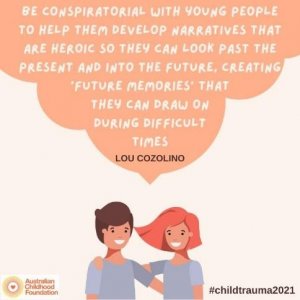
The Story Of Their Life: Supporting young people in care to make sense of their world
This ‘The story of their life: supporting young people in care to make sense of their world’ blog article was written by Jennifer Gay, Team leader, with contributions from the wider Victorian Therapeutic Services team at the Australian Childhood Foundation.
For many of the young people in Out-of-home care their lives have been characterised by many moves from one household to another and numerous losses of relationships from their biological families and through several foster care homes. Belongings and keepsakes that tell the stories of childhood are often not kept and cherished as they habitually are for other children and it is unfortunately not out of the ordinary for a child to turn up at placement with their few meagre possessions in plastic bags.
The stories that weave the tapestries of their past frequently therefore are lost as there is often no one person who holds this for them, as professional workers change over time and even agencies change if placements are not able to be sourced. Children’s brains try to make sense of what has happened to them and in the absence of information they will make up a story.
Understanding the young person’s life history and pulling that together into an integrated and coherent narrative is a fundamental part of the work of a Therapeutic Specialist.
This could be seen as telling the story of the young person’s life and helping to integrate the past, present and future, and does not have to occur as the more formal therapeutic life story work approach developed by Richard Rose.
This making meaning for the young person and helping those adults around them who support them is an important part of the Therapeutic Specialist’s role and is about empowering them. This work can take many forms and may be undertaken through individual work or by supporting the care team to consider how best this outcome would be achieved for the young person. It might include helping the young person to develop their capacity to wonder – for example “I imagine that when your mum first saw you smile at her she felt…”. This is particularly helpful in the absence of any information about their early life and can help them build a picture. This might also involve positive memories such as their favourite meal they used to have with their family.

Connecting with the parents and extended family, if possible, with a focus on highlighting positive memories can be very helpful in clarifying what are often distorted stories and third hand accounts. In that way, the Therapeutic Specialist might help bridge the gaps in the information and support potential confusing feelings the young person may hold towards their family that they are no longer living with.
A helpful tool may be the use of therapeutic letters. In a previous blog article ‘Incorporating Therapeutic Letters into the Assessment Process with Children and Young People‘, author Laura Pyle describes how letter writing has been widely used, particularly within Narrative Therapy. She shares how the use of a therapeutic letter “creates an opportunity to provide the child with an experience of being seen, understood and accepted”. Using a letter to the young person to make meaning of their life story provides an opportunity to engage the young person in a way that might feel less threatening to them. It allows for them to return to and read over whenever they choose. These letters would be tailored to the unique story of each young person and be something that you write to them or may also be used as something you create together with the young person as a letter or book for others to understand their story.
There is much power to be gained from the carers who hold a parental and primary attachment figure role in the young person’s life to be involved and take a leading role in creating the story of the young person’s life. In this way their past history can be integrated with when they joined the carers’ family and planning with hopes for the future.
In a recent ACF International Trauma Symposium Lou Cozolino shared his view of being conspiratorial with young people in developing their narratives. Indeed, Lou in his work talks about stories as being the key way to understand who we are; the function of them being to organise the conscious aspects of self-identity and to regulate affect by putting feelings into words and connecting feelings with thoughts.
In this way, the role we undertake in supporting the young person to first of all uncover, and then to understand and integrate the story of their life will be a powerful healing tool in their journey.
